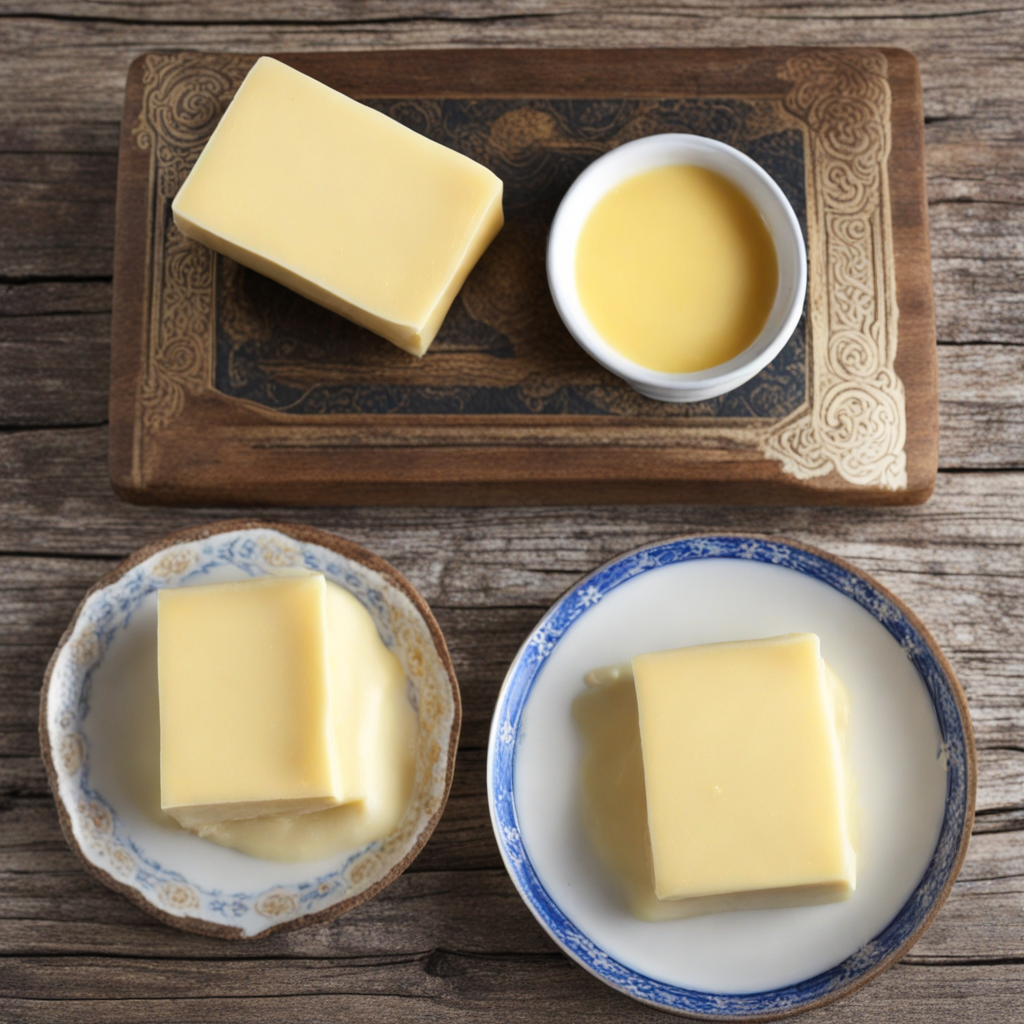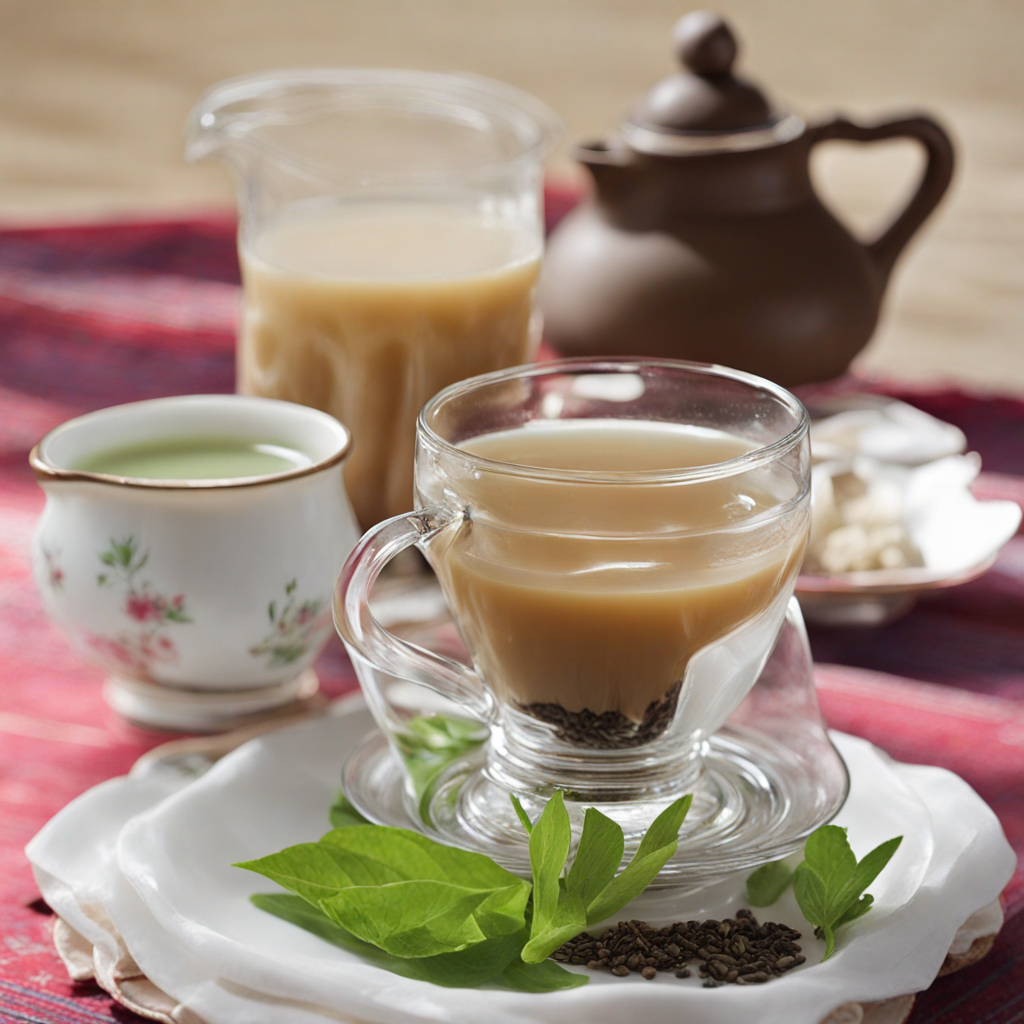Yak Butter
Yak butter, a traditional staple in Mongolia, is a rich and creamy dairy product made from the milk of yaks. With its golden-yellow hue, this unique butter has a distinctive flavor profile that sets it apart from regular cow's butter. The taste is slightly nutty and earthy, with a hint of sweetness, which can be attributed to the high altitude and the specific grazing habits of yaks. This butter is often used in a variety of Mongolian dishes, adding depth and richness to both savory and sweet recipes, making it a versatile ingredient in local cuisine. In Mongolian culture, yak butter holds significant importance, often used in traditional beverages like butter tea, known as “suutei tsai.” This comforting drink combines the butter with tea, milk, and salt, creating a warm and hearty beverage that is consumed daily by many Mongolians. The addition of yak butter not only enhances the flavor but also provides essential calories and nutrients, which are especially valuable in the cold, harsh climates of Mongolia. The creamy texture of the butter melts seamlessly into the tea, creating a luxurious mouthfeel that is both nourishing and satisfying. Yak butter is also enjoyed in various forms, including as a spread on bread or as an ingredient in local dishes like buuz (steamed dumplings) and khuushuur (fried meat pastries). It can be used in sauces and dressings, lending a unique twist to familiar flavors. For those looking to explore new culinary horizons, yak butter offers an exciting taste experience that embodies the rich traditions and flavors of Mongolia, allowing adventurous eaters to discover the unique essence of this remarkable dairy product.
How It Became This Dish
The Culinary Heritage of Yak Sarmis: A Mongolian Delight Origin and Historical Context Yak Sarmis, a traditional Mongolian dish, is a testament to the country’s nomadic way of life and its unique geography. The dish, which features ingredients derived from the yak, is rooted in the nomadic cultures of Mongolia, where livestock rearing plays an integral role in sustenance and identity. The yak, a resilient animal adapted to the harsh climates of the Central Asian steppes, has been domesticated for thousands of years, providing not just meat but also milk, butter, and wool. The origins of Yak Sarmis can be traced back to the Mongolian Empire, which flourished in the 13th and 14th centuries under the rule of Genghis Khan. During this period, the Mongolian diet was heavily influenced by the availability of natural resources, with a strong emphasis on animal husbandry. The nomadic tribes relied on their herds for food, clothing, and shelter, leading to a culinary tradition that celebrated the bounty of the land. Ingredients and Preparation At its core, Yak Sarmis is a dish made from finely chopped yak meat, often combined with a variety of vegetables, herbs, and spices. The preparation begins with the careful selection of yak meat, which is prized for its rich flavor and lean quality. The meat is usually mixed with ingredients such as onions, garlic, and locally grown vegetables, forming a hearty filling that is then encased in dough. The dough for Yak Sarmis is traditionally made from flour, water, and a pinch of salt, resulting in a pliable texture that can be rolled out and formed into dumpling shapes. Once filled, the dumplings are often boiled or steamed, allowing the flavors to meld and develop. The dish can be served with a side of broth or accompanied by a dipping sauce, enhancing the overall taste experience. Cultural Significance Yak Sarmis holds a significant place in Mongolian culture, embodying the spirit of hospitality and communal dining that is central to Mongolian life. Traditionally, when guests arrive, it is customary for hosts to prepare an array of dishes, with Yak Sarmis often being a highlight of the meal. The dish symbolizes generosity, showcasing the host's culinary skills and the quality of their livestock. In addition to its role in hospitality, Yak Sarmis also reflects the seasonal rhythms of Mongolian life. With the nomadic lifestyle deeply intertwined with the natural environment, the dish is often prepared during festivals and gatherings that coincide with significant times of the year, such as the Naadam Festival, which celebrates the “Three Manly Games” of wrestling, horse racing, and archery. During these occasions, communal meals featuring Yak Sarmis foster a sense of belonging and cultural continuity among participants. Development Over Time As Mongolia has evolved, so too has the culinary landscape, including dishes like Yak Sarmis. The collapse of the Soviet Union in the early 1990s brought significant changes to Mongolia's economy and society, leading to a resurgence of traditional practices and a renewed interest in indigenous foods. This period saw an increase in the appreciation of Yak Sarmis, as it became emblematic of national pride and cultural heritage. In modern times, Yak Sarmis has transcended its traditional roots, evolving to incorporate new flavors and ingredients. As globalization has made its mark, chefs in urban areas like Ulaanbaatar have experimented with fusion elements, introducing spices from other regions or adapting cooking techniques to appeal to a broader audience. Despite these changes, the core essence of Yak Sarmis remains intact, serving as a bridge between Mongolia's past and present. The rise of the culinary tourism industry in Mongolia has also contributed to the dish's prominence. Visitors from around the world seek authentic experiences, often finding themselves at ger camps where they can enjoy traditional meals, including Yak Sarmis. This exposure has helped to elevate the dish’s status, allowing it to gain recognition beyond Mongolia’s borders. Nutritional Aspects Beyond its cultural significance, Yak Sarmis is also valued for its nutritional benefits. Yak meat is known for its high protein content and lower fat levels compared to beef, making it a healthy option for those seeking nutritious meals. The incorporation of vegetables in Yak Sarmis adds essential vitamins and minerals, contributing to a balanced diet. As health consciousness grows worldwide, dishes like Yak Sarmis appeal to those looking for wholesome, hearty meals. Conclusion Yak Sarmis is more than just a dish; it represents the rich tapestry of Mongolian history, culture, and identity. From its origins in the nomadic lifestyle of the Mongolian steppes to its development in contemporary society, Yak Sarmis remains a symbol of resilience and adaptability. As Mongolia continues to navigate the complexities of modernization while cherishing its heritage, Yak Sarmis stands as a delicious reminder of the enduring legacy of its people. Today, Yak Sarmis is celebrated not only for its flavors and nutritional value but also as a cultural artifact that connects generations. It invites both locals and visitors alike to partake in a shared culinary experience, fostering connections through food. As the world becomes increasingly interconnected, dishes like Yak Sarmis serve as a delicious reminder of the importance of preserving culinary traditions while embracing the future.
You may like
Discover local flavors from Mongolia







